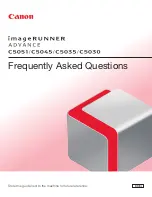
Identifying and Isolating Problems
8-3
T
ro
u
b
lesho
ot
ing
8
Remedy
Check the following:
•
If the dial-up router does not have to send packets via broadcast, change the
router settings to ensure that it sends packets via a method other than
broadcast. If dial-up router has to send packets via broadcast, check that the
settings are correct.
•
Check that the file or mail server’s host name or IP address set on the
machine is correct.
•
If you attempt to use a DNS server on an external network to access a device
on the network to which the machine is connected, set the destination using
an IP address, not a host name.
•
If information about a device on an external network is set on the DNS server
on the network to which the machine is connected, check the settings.
Detailed information concernin
g
the machine cannot be
s
et or
brow
s
ed u
s
in
g
the Remote UI or utility.
Cause 1
The IP addresses of computers on which the Remote UI or utility is used are not
allowed by the machine.
Remedy
Check the settings for <IP Address Range>. If the machine is set to restrict
access from the IP address of a computer, you cannot browse the machine’s
information from the computer using the Remote UI. (See “Setting the IP
Address Range,” on p. 6-21.)
Cause 2
HTTP is disabled.
Remedy
Set Use HTTP to ‘On’, and make sure that the same port number set in the
machine is used on the browser. (See “Setting the Use of HTTP,” on p. 3-33.)
Cause 3
The Remote UI is disabled.
Remedy
Set Remote UI On/Off to ‘On’. (See “Restricting the Use of Remote UI,” on
p. 6-34.)
Cause 4
SNMP is disabled.
Remedy
Enable SNMP. (See “Communication Environment Settings,” on p. 2-5.)
Cause 5
The SNMP community name does not match.
Remedy
Check that the correct SNMP community name is used. If the SNMP community
name set for your utility is different from the one set for the machine, the utility
will not detect the machine. (See “Communication Environment Settings,” on
p. 2-5.)
















































